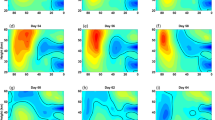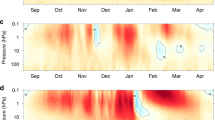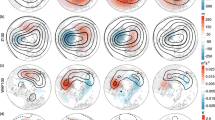Abstract
RANDEL et al.1 have observed tongues of stratospheric air stretching from the tropics into middle latitudes, and conclude that such events may be responsible for transporting significant amounts of stratospheric air across the tropical–mid-latitude barrier2. Here I examine the movements of air parcels during these events using high-resolution contour-trajectory calculations. My calculations suggest that the tongues of tropical air are associated with disturbances of the stratospheric polar vortices. The edge of the disturbed polar vortex reaches low latitudes, and draws a long tongue of tropical air around the vortex into middle latitudes. This process occurs in the winter of both hemispheres, although the edge of the larger Antarctic polar vortex reaches farther toward the Equator, and draws up material from lower latitudes, than its Arctic counterpart.
This is a preview of subscription content, access via your institution
Access options
Subscribe to this journal
Receive 51 print issues and online access
$199.00 per year
only $3.90 per issue
Buy this article
- Purchase on Springer Link
- Instant access to full article PDF
Prices may be subject to local taxes which are calculated during checkout
Similar content being viewed by others
References
Randel, W. J. et al. Nature 365, 533–535 (1993).
Trepte, C. R. & Hitchman, M. H. Nature 355, 626–628 (1992).
Mclntyre, M. E. & Palmer, T. N. Nature 305, 593–600 (1983).
Mclntyre, M. E. & Palmer, T. N. J. atmos. terr. Phys. 46, 825–849 (1984).
Leovy, C. B. et al. J. atmos. Sci. 42, 230–244 (1985).
Waugh, D. W. & Plumb, R. A. J. atmos. Sci. (in the press).
Norton, W. A. J. atmos. Sci. (in the press).
Schoeberl, M. R. & Bacmeister, J. T. Impact of the Stratosphere on Climate and the Biosphere (Kluver, in the press).
Dritschel, D. G. Comput. Phys. Rep. 10, 77–146 (1989).
Plumb, R. A. et al. J. geophys. Res. (in the press).
Waugh, D. W. et al. J. geophys. Res. (in the press).
Hoskins, B. J., McIntyre, M. E. & Robertson, A. W. Q. Jl. R. met. Soc. 111, 877–946; 113, 402–404 (1985).
McIntyre, M. E. The Use of EOS for Studies of Atmospheric Physics 313–386 (North-Holland, Amsterdam, 1992).
Anderson, J. G. et al. J. geophys. Res. 94, 11465–11480 (1989).
Tuck, A. F. et al. J. geophys. Res. 97, 7883–7904 (1992).
McCormick, M. P. & Veiga, R. E. Geophys. Rev. Lett. 19, 155–158 (1992).
Mahlman J. D. & Umscheid L. J. Transport Processes in the Middle Atmosphere 251–266 (Reidel, Dordrecht).
Author information
Authors and Affiliations
Rights and permissions
About this article
Cite this article
Waugh, D. Subtropical stratospheric mixing linked to disturbances in the polar vortices. Nature 365, 535–537 (1993). https://doi.org/10.1038/365535a0
Received:
Accepted:
Issue Date:
DOI: https://doi.org/10.1038/365535a0
This article is cited by
-
Convective modes reveal the incoherence of the Southern Polar Vortex
Scientific Reports (2024)
-
Short-term stratospheric ozone fluctuations observed by GROMOS microwave radiometer at Bern
Earth, Planets and Space (2018)
-
Prediction of rainfall onset using a newly formulated potential vorticity intrusion index
Modeling Earth Systems and Environment (2018)
-
Subtropical Potential Vorticity Intrusion Drives Increasing Tropospheric Ozone over the Tropical Central Pacific
Scientific Reports (2016)
-
A new perspective on the dynamical link between the stratosphere and troposphere
Nature (1998)
Comments
By submitting a comment you agree to abide by our Terms and Community Guidelines. If you find something abusive or that does not comply with our terms or guidelines please flag it as inappropriate.



